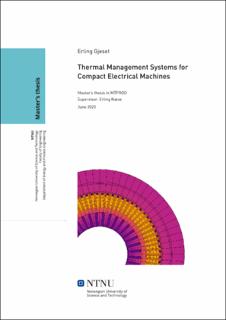| dc.description.abstract | Elektrifisering av luftfarten stiller høyere krav til elektromotorene som skal drifte hybride eller helelektriske fly. De må være kompakte, sikre og ha lav vekt. Dette krever mer av utviklerne innenfor alle ingeniøraspekter.
En samarbeidsgruppe bestående av elektroingeniører, maskiningeniører og termiske ingeniører har blitt satt sammen for å utvikle og evaluere en prototype av en høyhastighets-, elektrisk flymotor med en utvendig rotor. Denne raporten fokuserer på den termiske styringen av maskinen. To kjølesystem skal testes, en lukket oljekrets og en åpen luftkrets, for å se hvilken som er best i stand til å kjøle motoren under materialgrensetemperaturene. De to systemene integreres med elmotor-geometrien og simuleres numerisk.
Studiet viser at begge kretsene er potensielle kandidater, ettersom de er i stand til å opprettholde forsvarlige temperaturer i motoren ved relativt lav pumpekraft. Dette er på grunn av fordelingen av kjølekanaler, som benytter seg både av direkte og indirekte kjøling. Systemene har sine fordeler og ulemper når det kommer til den praktiske implementeringen i en flymotor, slik som vekt, innløps-/utløpskanaler, pumper, eksterne varmevekslere etc. Disse aspektene blir påpekt og vurdert, men kan ikke bli tallfestet, ettersom dette krever mer praktisk erfaring og/eller detaljstudier av de aktuelle komponentene.
I tillegg til hovedprosjektet har det blitt foretatt to detaljstudier: strømningsmodellering av luftgapet mellom stator og rotor, og homogeniseringsmodeller av viklingene i stator. Målet for begge var å finne gode "ingeniørmodeller" til bruk i termisk modellering av elektromotorer. Lignende studier fra litteraturen har blitt sammenlignet med numeriske beregninger.
I luftgapet vil luftstrømmene være turbulente og inneholde Taylor-virvler, som har vist seg vanskelig å modellere med den nåværende 2D-strømningsmodellen. Korrelasjonene fra tidligere arbeid viser dessuten store variasjoner basert på hvilke geometrier og grensebetingelser som er brukt i eksperimentene. Mer grundig analyse trengs for å finne en passende modell.
Homogeniseringsteknikkene som er funnet i litteraturen stemmer bra med den numeriske analysen. De mest moderne relasjonene er de som følger tettest opp mot simuleringene, ettersom de er i bedre stand til å ta i betraktning den komplekse geometrien. Til tross for dette får hverken av modellene til å fange opp "transposisjonseffekten" som er i litz-viklinger. Den sammenflettede strukturen til litz gjør seg vanskelig å generalisere, men nylige rapporter ser ut til å kunne klare dette ved hjelp av termiske resistansnettverk. | |
| dc.description.abstract | During the transition to more electric aircraft (MEA), more compact, lighter electric machines will be built to power the new planes. These motors place stricter requirements on performance from all engineering aspects.
A team of of students of electromagnetic, mechanical and thermal engineering will in this project design and evaluate a prototype, high speed machine with an external rotor configuration. This report focuses on the thermal management, constructing a cooling system capable of ensuring a sufficiently low operating temperature. Two separate methods are considered, a closed-loop and an open-loop system using oil or air, respectively. These are integrated with the motor geometry and evaluated through numerical software.
The study shows that either configuration is a good option for the thermal management system of the prototype, since they both manage to keep the temperatures below the material limits at relatively low pumping cost. This is due to the distribution of the cooling ducts, combining both direct and indirect cooling. However, both alternatives have their separate advantages and drawbacks considering the practical implementation onto an electric aircraft motor. This includes weight, ducting and pumping issues, ancillary heat exchanger sizing etc. These concerns are noted, but the study was not able to quantify their impact, as they require more real-life experience with the actual machine and/or more part-specific analysis.
Two separate, more detailed studies were also performed: flow modelling of the air gap between the stator and rotor, and the winding composite thermal conductivity. The aim was to find a good engineering correlation for use in the thermal modelling of electrical machines. Previous, similar models have been collected from literature and evaluated against numerical simulations.
The flow structure in the air gap exhibits both turbulence and Taylor vortices, and has proven too complex to be captured by the simplified 2D-model used in this report. Likewise, the correlations from previous work indicate strong dependencies on the experiments' geometry and boundary conditions, as they do not correlate well with each other. More in-depth research is needed within this field to find a more fitting model.
The homogenization techniques used for calculating the bulk thermal conductivity of windings are shown to correlate well with the more detailed, numerical results. The more recent relations are the ones following closest to the simulations, as they are able to account for more of the geometrical elements. However, these models relate to straight wire windings, and are not able to capture the transposition effect in twisted litz wire. In this case, the complex geometry proves difficult to generalize, though previous work shows promise in modelling such compositions as thermal resistance networks. | |
